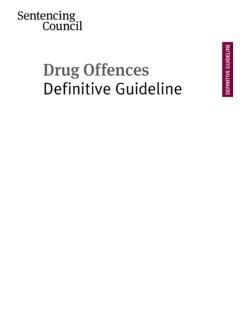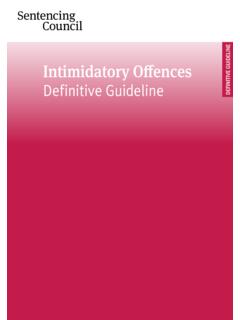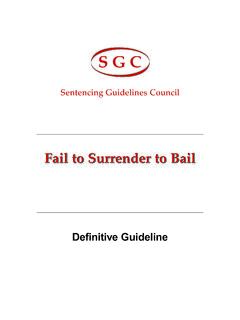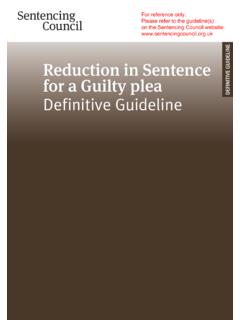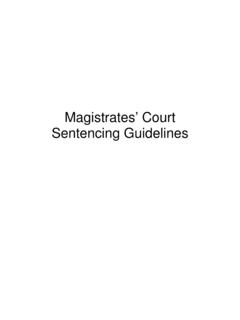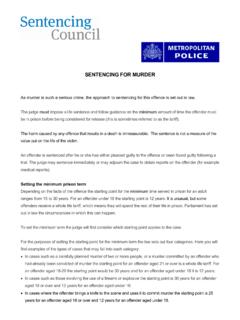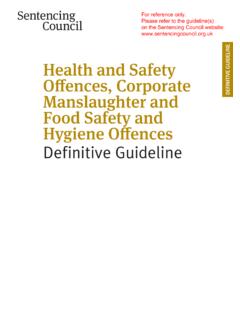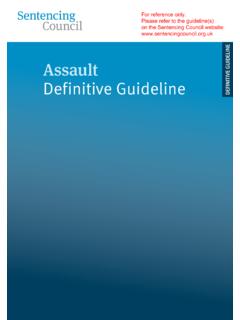Transcription of Burglary Offences - Definitive Guideline - Sentencing Council
1 Burglary OffencesDefinitive GuidelineDEFINITIVE GUIDELINEFor reference only. Please refer to the Guideline (s) on the Sentencing Council website: Burglary Offences Definitive Guideline 1 ContentsApplicability of Guideline 2 Aggravated Burglary (Theft Act 1968, section 10) 3 Domestic Burglary (Theft Act 1968, section 9) 7 Non-domestic Burglary (Theft Act 1968, section 9) 11 Annex: Fine bands and community orders 15 Crown copyright 2011 You may re-use this information (not including logos) free of charge in any format or medium, under the terms of the Open Government Licence.
2 To view this licence, visit write to the Information Policy Team, The National Archives, Kew, London TW9 4DU, or e-mail: reference only. Please refer to the Guideline (s) on the Sentencing Council website: 2 Burglary Offences Definitive GuidelineIn accordance with section 120 of the Coroners and Justice Act 2009, the Sentencing Council issues this Definitive Guideline . It applies to all offenders aged 18 and older, who are sentenced on or after 16 January 2012, regardless of the date of the 125(1) of the Coroners and Justice Act 2009 provides that when Sentencing Offences committed after 6 April 2010.
3 Every court (a) must, in Sentencing an offender, follow any Sentencing Guideline which is relevant to the offender s case, and(b) must, in exercising any other function relating to the Sentencing of offenders, follow any Sentencing guidelines which are relevant to the exercise of the function,unless the court is satisfied that it would be contrary to the interests of justice to do so. This Guideline applies only to offenders aged 18 and older. General principles to be considered in the Sentencing of youths are in the Sentencing guidelines Council s Definitive Guideline , Overarching Principles Sentencing , ranges and starting pointsFor the purposes of section 125(3)-(4) Coroners and Justice Act 2009, the Guideline specifies offence ranges the range of sentences appropriate for each type of offence.
4 Within each offence, the Council has specified three categories which reflect varying degrees of seriousness. The offence range is split into category ranges sentences appropriate for each level of seriousness. The Council has also identified a starting point within each points define the position within a category range from which to start calculating the provisional sentence. As in the Sentencing Council s assault Definitive Guideline , this Guideline adopts an offence based starting point. Starting points apply to all Offences within the corresponding category and are applicable to all offenders, in all cases.
5 Once the starting point is established, the court should consider further aggravating and mitigating factors and previous convictions so as to adjust the sentence within the range. Starting points and ranges apply to all offenders, whether they have pleaded guilty or been convicted after trial. Credit for a guilty plea is taken into consideration only at step four in the decision making process, after the appropriate sentence has been identified. Information on community orders and fine bands is set out in the annex at page of guidelineFor reference only.
6 Please refer to the Guideline (s) on the Sentencing Council website: Burglary Offences Definitive Guideline 3 Aggravated burglaryTheft Act 1968 (section 10)AGGRAVATEDThis is a serious specified offence for the purposes of section 224 of the Criminal Justice Act 2003 Triable only on indictment Maximum: Life imprisonmentOffence range: 1 13 years custodyBurglary Offences Definitive Guideline 3 For reference only. Please refer to the Guideline (s) on the Sentencing Council website: 4 Burglary Offences Definitive GuidelineAGGRAVATEDSTEP ONE Determining the offence categoryThe court should determine the offence category using the table 1 Greater harm and higher culpabilityCategory 2 Greater harm and lower culpability or lesser harm and higher culpabilityCategory 3 Lesser harm and lower culpabilityThe court should determine culpability and harm caused or intended, by reference only to the factors below, which comprise the principal factual elements of the offence.
7 Where an offence does not fall squarely into a category, individual factors may require a degree of weighting before making an overall assessment and determining the appropriate offence category. Factors indicating greater harmTheft of/damage to property causing a significant degree of loss to the victim (whether economic, commercial, sentimental or personal value) Soiling, ransacking or vandalism of propertyVictim at home or on the premises (or returns) while offender presentSignificant physical or psychological injury or other significant trauma to the victimViolence used or threatened against victim, particularly involving a weapon Context of general public disorderFactors indicating lesser harmNo physical or psychological injury or other significant trauma to the victim No violence used or threatened and a weapon is not producedFactors indicating higher culpabilityVictim or premises deliberately targeted (for example, due to vulnerability or hostility based on disability.)
8 Race, sexual orientation)A significant degree of planning or organisationEquipped for Burglary (for example, implements carried and/or use of vehicle)Weapon present on entryMember of a group or gangFactors indicating lower culpabilityOffender exploited by othersMental disorder or learning disability, where linked to the commission of the offenceSTEP TWO Starting point and category rangeHaving determined the category, the court should use the corresponding starting points to reach a sentence within the category range below. The starting point applies to all offenders irrespective of plea or previous convictions.
9 A case of particular gravity, reflected by multiple features of culpability or harm in step 1, could merit upward adjustment from the starting point before further adjustment for aggravating or mitigating features, set out on the next reference only. Please refer to the Guideline (s) on the Sentencing Council website: Burglary Offences Definitive Guideline 5 AGGRAVATEDO ffence Category Starting Point (Applicable to all offenders)Category Range (Applicable to all offenders)Category 110 years custody9 13 years custodyCategory 26 years custody4 9 years custodyCategory 32 years custody1 4 years custodyThe table below contains a non-exhaustive list of additional factual elements providing the context of the offence and factors relating to the offender.
10 Identify whether any combination of these, or other relevant factors, should result in an upward or downward adjustment from the starting point. In particular, relevant recent convictions are likely to result in an upward adjustment. In some cases, having considered these factors, it may be appropriate to move outside the identified category increasing seriousnessStatutory aggravating factors:Previous convictions, having regard to a) the nature of the offence to which the conviction relates and its relevance to the current offence.
